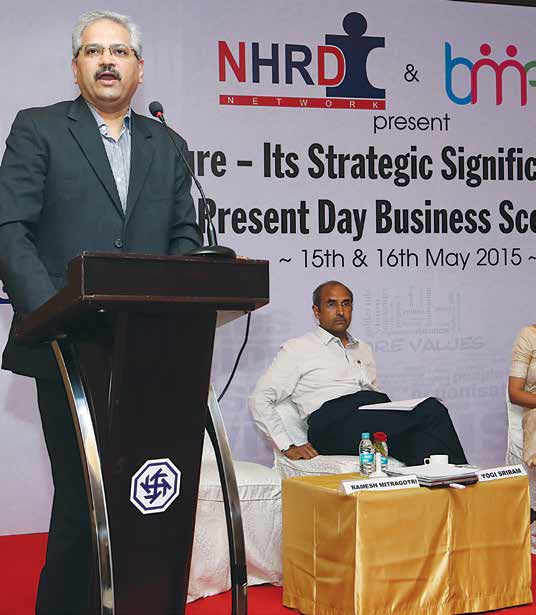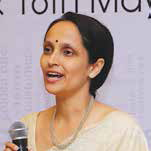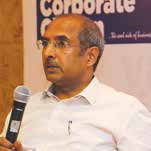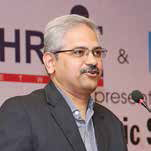Issue No.13 / September 16,2015

A one-and-a-half day round table meet was recently organised by the National HRD (NHRD) Network with the Bombay Management Association (BMA), on “Culture - Its strategic significance in the present day business scenario,” which explored several aspects of corporate culture. Corporate Citizen brings to you the session insights on ‘Why transformation efforts succeed or fail?’ discussed by top designates from the HR fraternity.
The session was facilitated by Ramesh Mitragotri, Group Head, Employee Relations and Innovations at Aditya Birla Group, and the panelists included Bhawana Mishra, Managing Director, Basil Tree Consulting, Yogi Sriram, Senior Vice President, Corporate HR, Larsen & Toubro and Zubin Mulla, Associate Professor, School of Management & Labour Studies, TISS.
Talking about how challenging it can be to adapt or respond to change, Mitragotri said it is especially so when it involves organisational culture, when it involves change in culture, when societies start adapting to change and look at culture. “What makes it even more challenging is not just responding but proactively anticipating what changes (are needed) and how we respond. The question then is if the culture is an influencer or it gets impacted by way of changes that happen in organisations, what role does culture play in an organisational transformation? Is it the cause, the effect, or an agent of change that we do,” he added.
Zubin Mulla: Cultural transformation is important given the change happening in the environment. It is a function of two things, one is the expected longevity of the organisation and second the extent of change that is happening in the environment. As you expect an organisation to remain alive for a long time and as the environment for which the organisation is designed to deal with keeps changing, it becomes imperative for the organisation to change on an on-going basis. And culture being one aspect, will need to change.
While we are discussing culture, why do we somehow get carried away by the notion of calling it either good culture or bad culture? Culture is culture” Bhawana Mishra

Culture is to an organisation, what the three doshas in Ayurveda are to people. Do we understand the psyche of the organisation before we start to make any interventions, which otherwise remains at a systemic level?
Yogi Sriram: Most of us in India are in a bit of a spoilt world, because our transformation and cultural change does not happen the way it does in the much more brutal world. In that world especially in IT and ITES, the cultural transformation is so extreme and so real that it perhaps is an example for every other sector. Today you take most of the IT companies, their 60-70 percent revenue comes from what is called horizon one. Horizon one is basically body shopping. It is sending warm bodies who know Java, CAD, know how to use various software for customers, for a predetermined outcome. So there is a pre-sales and sales team and all they do is sell services at $ 21-25 per hour (Rs.1593.5)
Words like smack, cloud, internet of things, digitization and so on, will have a huge transformational effect. The reason why transformation is prevented from happening as fast as it should, is a danger signal for companies, in India particularly. What is the obstacle? Reason number one is arrogance. Arrogance comes out of success, arrogance comes out of having high revenues, arrogance from having a high EBITDA, PBIT or PIT, thus success makes you fail. The second reason is complacency: ‘Things will change…but we are strong in our market and we need to worry about quarter after quarter of profits after tax and therefore thinking about the future is something that can be postponed.” The third is hubris (dismissing it) - it is right there at your door step staring at you. You are getting decadent, but the transformation is not happening because of the hubris, and that happens because of comfort with the past.
‘The first is the importance of a large vision and big audacious goals, but the vision has to be something which has something in it for the employee’ Zubin Mulla

Bhawana Mishra: In the last three to four years a large Indian conglomerate with businesses across industry sectors tried to bring about such change. One of the key issues they were blamed for was a very centralised culture which was seen as negative because of its slow decision making. So the organisation started with a programme to decentralise businesses, create small business units and let individual CEOs and SPUs take the entire ownership to take the organization forward. Where is the organisation? Did the whole initiative succeed? Two years later - absolutely not. The reasons were multiple. Firstly, it was fine to do that on paper, as something done by all large multinationals conglomerates. But intuitively, as an underlying theme for who you are in terms of values, ethos, what drives you, are the promoters and the entire top team ready to make that change at their level or is it going to be just something you are espousing because it is the right thing to do? Secondly, while the organisation got restructured and a whole lot of other things got done, the most important element was, ‘what’s in it for me’ as a question for the entire organisation and the people that sat in those organisations. Did that get answered?. And that ‘what’s in it for me’ is very different for different sets of people, and was found to be one of the biggest issues of this particular failure. I don’t think it is documented as failure but at a tacit level it is probably recognised as one.
‘Money goes contrary to culture. I find that in companies where there is a lot of money being paid at 90th percentile, or 100th percentile or whatever, there is actually a lot of politics’ Yogi Sriram

Zubin Mulla: Coming to the architecture of organisation transformation, a couple of things are required. The first is the importance of a large vision and big audacious goals, but the vision has to be something which has something in it for the employee. Individuals should feel connected to the vision. It is one thing to say that we will double our turnover in five years which doesn’t have any meaning for an individual and quite another to say we will change the world or we will be the best, which an individual can personally connect to. The other area is to have an ideology which involves the people. One part of transformation is changing how you think, which comes from that large vision people are connected to. Another part of transformation is changing what people do and in order to change that, you need to have an improvement ideology that involves people.
If you look at the Indian freedom movement, we had a number of politicians talking about freedom and you had Gandhi who had come with the concept of not just political freedom but Swaraj. Swaraj is complete freedom, which is meaningful to the people, whereas political freedom does not make sense to most people. Gandhi supported his ideology of Swaraj with Satyagraha or Ahimsa, which was an operational ideology and khadi which made it easy for people to follow it. Right at the ground level if I had to follow Gandhi, there is a simple to-do action plan, which helps me to follow. Organisations need to work with that along with the big picture.
Yogi Sriram: HR can use concrete data, also use a lot of technology to pick up what are individual preferences. It is not only about cohorts, it is about individual preferences and trying to derive patterns and creating conversations with people who are at leadership level.
Bhawana Mishra: I would have three roles for HR in the context of whether it’s culture, or any kind of change programme. Go back to the classical ‘why’, ‘who’ and ‘how’ of anything that you are trying to do, whether it is a change process or whatever else. What is it that the company is trying to do, and move from one point to the other point? That ‘why’
of it varies from individual to individual and one section of the organisation to the other. Defining that ‘why’, understanding that ‘why’, and building compelling stories across the organisation is one key role for HR. That ‘why’ need not necessarily resonate with the people all the time, or all groups of people within the organisation. So understanding different needs of the people within the organisation, what drives them, what motivates them and therefore what the ‘why’ and the story might be for them, and bringing that out and involving them, is the first real role for HR to play, in the ‘why’ of it.
So the first is the ‘why’ of it, which is creating stories and HR has a big role in finding those stories across the organisation and getting people to become champions. The second is the ‘who’. Identifying who those ‘who’ will be is really HR’s responsibility and need not always be that of the top leaders, the function heads or business heads. And these ‘who’s’ are there across the organisation, HR has the best access to identify those who’s’ and make them champions of whatever it is the organisation is trying to do. The third -- which is really the systemic role of HR -- is around capability building for whatever the organisation is trying to become -- and supporting that capability building with structural change, process, reward mechanism and what have you, to reinforce the new behaviour that you are trying to build in the organisation.
Yogi Sriram: What can HR do specifically? Pay only a 50th percentile. Most of us do a copout taking this benchmark of compensation studies and then we tell our top management, we must be giving the high performers 75 or 80 percentile. I think you should challenge yourself. HR has a role in actually insulating top performers. What can HR do specifically is not hide behind compensation surveys and mourn and groan that attrition is 18 or 15 percent and start making vicious presentation to the top management saying, ‘we must do it….look at what so and so company has done.’
Yogi Sriram: Money is ugly, I am not saying because I have plenty of disposable income. Money goes contrary to culture. I find that in companies where there is a lot of money being paid at 90th percentile, or 100th percentile or whatever, there is actually a lot of politics. When you make a pre-placement talk, what is very important is the stories that go around from seniors to the juniors, about the space that is available in the company. An organisation that has a huge investment in learning and development, which is structured, is perhaps more successful than other companies that just pay and don’t spend enough on those, because they are continuously building insurance. Every L&Tite has a big CV and knows if he/she wants to go, he/she can go.
Zubin Mulla: The way I look at the role of HR in change initiative is more like a DJ and the task of the DJ is two-fold, one is to bring in an environment in which everyone can dance. The environment ideally has to be such that everyone can be part of it, not just one group and exclude another group. Getting everyone on the dance floor gives the right role model across the board and that’s what really drives the change.
Bhawana Mishra: While we are discussing culture, why do we somehow get carried away by the notion of calling it either good culture or bad culture? Culture is culture, it’s a bit like going back to my Ayurveda example and the three doshas. You are the dosha that you are or combination of all of those and the whole point is of being able to understand what you are, what works for you and in that context how are you going to run the organisation. And that’s very important for us to understand as HR professionals. One thing that works for one company, needn’t necessarily work for another. Some of the best examples of wellrun organisations which are emulated by people the world over, for example, would be some of the highest payers talking of compensation per se.
Zubin Mulla:One is, deal with the past. Have a big vision which is meaningful. Provide an inclusive ideology. Create role models at every level. Finally review your change processes on a regular basis and provide feedback to people on how they are doing and recognise success.
Bhawana Mishra: One benefit smaller organisations have is nimbleness, simply because of size and a relative ease in understanding what the expectations from the senior leadership/ promoters/ owners will be. So if that is relatively well understood then it is that much easier to percolate across through processes and whatever else it is that you are trying to really do for the organisation. It is that much more complex in a larger setup because those needs and expectations and what you set out to do will vary by your geographies, your markets, your segments of business and so on. The smaller and larger setups will be vastly different, understanding what my culture is not about good or bad, it’s about understanding what my culture is on a set of dimensions.
Yogi Sriram: Strong culture is a culture which is difficult to copy. Copying culture is not easy and I think the strength of a culture is defined by how difficult is it to emulate it, it’s built over the years, it’s the way things are done. It may be succession planning, it may be how you treat people, it may be what an organisation does, caring for people when the chips are down. There are a whole lot of things that builds into that culture - that is what it means by strength. Strength could be in the form of almost paralysing the company and not making it agile enough to change with time. So the same competitive strength can become a weakness if the culture is so set that people keep looking over the shoulders and say, we have been doing this for so many years, as our founder did that. It’s called the founders’ mentality and they live under the founders’ shadow. That of course is very debilitating.
Yogi Sriram: Firstly, creating a sense of urgency by the leadership is very important, even creating an artificial urgency if you are clear about moving into a particular technology or moving into a particular strategy. The second is to tune your culture…to have a conversation that is deep enough about culture. Most of the strategic consultants deal with this subject in a very perfunctory manner.
They just say, HR is very important and HR should do this and do that to change the culture.
Thirdly, even if there is a due diligence done, if you are taking over another company or you are demerging or getting into another or whatever, the culture dimension is extremely important in understanding whether it will be a successful merger or not. Many companies have fallen flat only because of this one reason. Even if it means taking over another customer what they call in IT language ‘badging and rebadging’, it just might fail because of culture.
Zubin Mulla: Essentially the norms are so strong that there is not enough flexibility for individuals to behave in violation of those norms - that’s the definition of a strong culture. Here a couple of roles come in terms of the role of the leader. One of the jobs of the leader is to understand what is essential to that organisation and what is peripheral. So when we talk about change and transformation, we are not talking about radical change, we are talking about essentially unleashing some inherent capabilities into the organisation.
And there is also an element of framing, where the task of the leader is to essentially articulate what those essential elements are to the organisation, which are enduring and permanent, and what are peripheral, and which are those that affect its ability to compete in the current environment.
‘The value proposition is about what that organisation does to really inspire the people to deliver much more than what they could have otherwise done’ Ramesh Mitragotri

Yogi Sriram: We are all wired differently. Many people feel that this conversation about suppressing compensation is highly manipulative because we are in a way trying to take away the fundamental right, or something which is very important to the people. Not at all, what I am trying to say is that it is something very transitory, so elastic, so frivolous.
Yogi Sriram: (The right time is) whenever you feel your company is not going to survive unless you change. I am not talking about people changing, but your business model changing. Many companies in IT have to move from horizon 1 to horizon 2 or 3, because if they stick around with horizon 1 their revenues will be 70-80 percent, they would be absolutely dead. The model of sending a massive number of people who know Java or particular language to customers in America and Europe is not going to be good enough for the future. Those companies have already moved ahead and the CIOs will not be deciding anymore, it’s the CMO who decides. Therefore companies using the SMAC, or big data and so on, are more relevant. When the chief executive thinks that you have come to the inflection point, it is the point when the conversation of culture is extremely important.
Yogi Sriram: In our culture we don’t chase people with extra money. We chase them with a lot of love and affection. We certainly don’t increase compensation to keep people back. The entire conversation is changing in the IT world. where utilisation rates and so on are absolutely redundant. In times to come, people are not going to talk my 78 per cent is in TCS, 82 per cent is L&T Infotech, as all that is redundant. People are going to work more like consultants, they will have to go find the work. There is going to be 100 percent utilisation in such companies. Therefore, the conversation in horizon 2 will be more about doing things that change and sculpt consumer behaviour. It’s not about responding to consumer behaviour. Where there is a huge scope for sculpting the kind of talent that you have around that have imagination…to understand how you really hook the consumer to certain patterns.
By Rajesh Rao and Mahalakshmi Hariharan